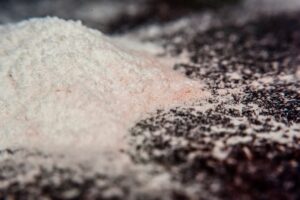Consumers who have used any product that contains talc for an extended period are possibly at risk of developing certain forms of cancer. Some talc deposits also contain asbestos, which can make its way into consumer products. For decades, consumers purchased talc powder and products that potentially contained asbestos. As a result, many of them have developed different types of cancer, including ovarian and breast cancer. These victims have filed multiple lawsuits against the manufacturers of these products, and some have won significant verdicts.
 Talcum powder is potentially laced with asbestos because it is in the ground near asbestos and talc deposits. When companies mine talc, it can contain asbestos particles, and it is usually impossible to separate the two. As a result, the product manufacturer may receive talc-containing asbestos.
Talcum powder is potentially laced with asbestos because it is in the ground near asbestos and talc deposits. When companies mine talc, it can contain asbestos particles, and it is usually impossible to separate the two. As a result, the product manufacturer may receive talc-containing asbestos.
Not every product containing talc powder contains asbestos. It depends on how the company mines talc from the ground and whether it is near an asbestos deposit. When the Food and Drug Administration (FDA) tests talc for asbestos, many samples are asbestos-free.
The manufacturers point to these samples when they argue that their product is entirely safe. However, other samples are likely positive for asbestos; some may contain more than trace amounts. If they have used the product for years, regular talc powder users are likely to purchase many bottles containing asbestos. Thus, they are still victims of asbestos exposure, which may cause them to develop an illness.
The asbestos fibers in talc powder do not leave the body because they are tiny particles that do not break down over time. The fibers cause inflammation and scarring, possibly a precursor to a cancerous tumor. In fact, one of the reasons asbestos was popular is its durability and resistance to elements.
Asbestos in talc powder can cause the following types of cancers:
Companies that make talc powder products have known the potential dangers for years. Research studies dating back to the 1950s and 60s show the possibility that talc may contain asbestos. Researchers published these studies around the same time the public became aware of the dangers of asbestos. Even though talc powder manufacturers were fully aware of this research, they continued to sell these products for decades. In internal emails, Johnson & Johnson executives referred to talc powder as a “sacred cow” since the product was central to the company’s image. These companies persuaded the FDA to take a hands-off approach, even in light of decades of research that revealed potential dangers in these products.
In a recent year, independent watchdogs conducted tests of talc-based cosmetics and discovered that many contained asbestos. This testing occurred when talc powder makers such as Johnson & Johnson faced lawsuits from thousands of consumers who claimed their cancers resulted from talc powder. Because of multiple lawsuits, Johnson & Johnson finally agreed to pull its talc powder from the market after disputing the possible dangers for years.
 Johnson & Johnson has already had to pay billions of dollars in compensation to plaintiffs who filed personal injury cases and families who have claimed wrongful death. Recently, a group of women who developed ovarian cancer sued the company in Missouri state court. The jury returned a verdict against Johnson & Johnson and ordered the company to pay $4.7 billion.
Johnson & Johnson has already had to pay billions of dollars in compensation to plaintiffs who filed personal injury cases and families who have claimed wrongful death. Recently, a group of women who developed ovarian cancer sued the company in Missouri state court. The jury returned a verdict against Johnson & Johnson and ordered the company to pay $4.7 billion.
Much of the verdict was punitive damages because the jury reacted angrily to the company deliberately ignoring the danger of its product and continuing to sell asbestos-laced talc powder. Even on appeal, the Missouri Supreme Court upheld the verdict and allowed most of the damages to stand (the court reduced the verdict to $2.5 billion). Johnson & Johnson even unsuccessfully tried the “Texas two-step” to avoid the full scope of its liability through bankruptcy.
If you have developed cancer from the use of any product that contains talc powder, you may have the legal right to substantial financial compensation. You can file a product liability lawsuit, potentially resulting in a jury verdict in your favor or a settlement with the defendant.
There is currently multidistrict litigation against Johnson & Johnson in federal court in New Jersey. There are nearly 60,000 lawsuits that are pending as part of the multidistrict litigation. In these types of cases, each one goes separately to a jury, but there is a standard set of discovery procedures to help you build your case. The company continues to try to spin its liability off to a newly created subsidiary, which is a prepackaged bankruptcy containing $8 billion allotted to settle talc powder claims. The company fully realizes the extent of its possible liability and is aggressive about potentially cutting its overall bill.
If you believe you have suffered an injury using talc-based products, contact a product liability lawyer. They can investigate your case and potentially file a lawsuit on your behalf. If you can prove that your cancer was the result of your use of talc powder (and you will need to prove causation in a product liability case), you may deserve substantial financial compensation. You never have to pay a product liability attorney anything unless you receive money for your injuries.
By hiring a product liability lawyer, you are seeking justice for yourself and protecting others from the dangers of asbestos. Your case can raise awareness about the hazards of asbestos products and hold those responsible accountable, potentially preventing future harm to individuals.
If you are a victim of asbestos exposure and have developed health problems as a result, it is essential to seek legal representation from a product liability lawyer. They have the experience and skills to handle the legal process, gather evidence, and fight for your rights to fair compensation. Do not hesitate to contact a lawyer to discuss your situation and explore your legal options.